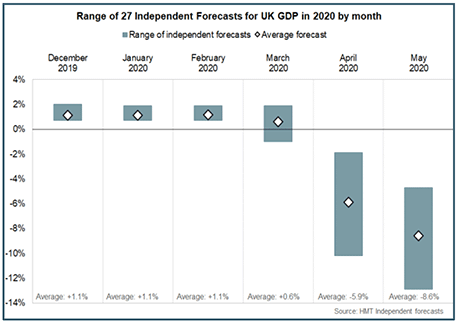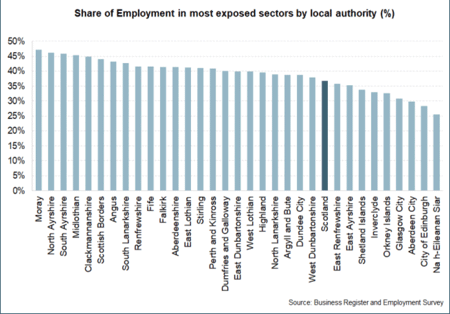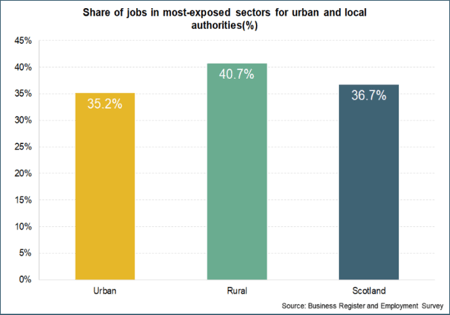Monthly economic brief: June 2020
Provides a summary of latest key economic statistics, forecasts and analysis on the Scottish economy.
This document is part of a collection
GDP Growth Outlook
The economic outlook for 2020 has deteriorated significantly as a result of the coronavirus pandemic and the necessary restrictions on economic activity to minimise the spread of the virus.

- The scale and duration of the economic impacts remains uncertain, however the degree of pessimism in forecasts has increased over the course of the year.
- Scotland's scenario analysis published in this edition, suggests GDP could fall by 14% in 2020.
- Scenario analysis from the Bank of England estimates UK GDP could fall by 14% over the year while HM Treasury's monthly summary of independent GDP forecasts reports UK GDP is forecast to contract by an average of -8.6% in 2020 (down from -5.9 in April 2020).
COVID-19 Regional Exposure and Resilience

Regional exposure to the impacts from COVID-19 will vary due to the varied composition of industrial, workforce and wider population structures.
Recent Scottish Government analysis developed a sectoral risk rating based on exposure to international supply, international and domestic demand and labour market disruptions[14]. The adjacent chart shows the share of employment in these sectors where overall risk exposure to the economic effects of COVID-19 may be greatest across Scotland's 32 local authorities. Island local authorities and some urban areas have lower shares of employment in the most exposed sectors.

Overall, local authorities that are rural or mainly rural have slightly higher shares of jobs in the most-exposed sectors.
However, the number of jobs in the most exposed sectors is highest in Glasgow, Edinburgh and Fife.
| Area | Number of jobs in sectors most exposed to COVID-19 risks |
|---|---|
| Scotland | 958,000 |
| Glasgow City | 128,000 |
| City of Edinburgh | 100,000 |
| Fife | 57,500 |
| North Lanarkshire | 53,500 |
| Aberdeen City | 52,500 |
| South Lanarkshire | 51,000 |
| Highland | 50,000 |
| Aberdeenshire | 47,500 |
| Renfrewshire | 36,500 |
| West Lothian | 30,750 |
| Dundee City | 29,250 |
| Perth and Kinross | 28,000 |
| Dumfries and Galloway | 27,500 |
| Falkirk | 27,500 |
| South Ayrshire | 22,000 |
| Scottish Borders | 21,250 |
| Stirling | 20,500 |
| North Ayrshire | 20,000 |
| Moray | 18,500 |
| Angus | 17,000 |
| Argyll and Bute | 15,250 |
| East Ayrshire | 15,250 |
| Midlothian | 14,400 |
| East Lothian | 13,500 |
| West Dunbartonshire | 12,250 |
| East Dunbartonshire | 10,900 |
| Inverclyde | 9,350 |
| East Renfrewshire | 8,050 |
| Clackmannanshire | 6,850 |
| Shetland Islands | 5,350 |
| Orkney Islands | 4,250 |
| Na h-Eileanan Siar | 3,950 |
Other factors, such as the level of international exports, the structure of the business base, and the existing health status of the local population will also impact on the regional exposure to the impacts of COVID-19. There were significant variations in regional social and economic outcomes prior to the current crisis and local resilience and recovery will be influenced by a range of factors, such as the existing levels of deprivation, labour market performance, and qualifications of the population.
For example, areas such as Glasgow, Dundee, Inverclyde and North Ayrshire have higher levels of income deprivation and median hourly earnings for employees in 2019 ranged from £10.79 in Dumfries and Galloway and £19.32 in East Renfrewshire[15][16]. The proportion of the population with degree qualifications also varies significantly, from 11.6% in Shetland to 50.7% in Edinburgh[17].
There is considerable uncertainty regarding the economic outlook and understanding the regional impacts and recovery paths will be important to ensuring that the specific needs of Scotland's regions are supported.
Contact
Email: OCEABusiness@gov.scot
There is a problem
Thanks for your feedback